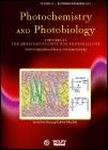版权所有:内蒙古大学图书馆 技术提供:维普资讯• 智图
内蒙古自治区呼和浩特市赛罕区大学西街235号 邮编: 010021

作者机构:US Dept Vet Affairs Vet Affairs Edward Hines Jr Hosp Res Serv Hines IL 60141 USA US Dept Vet Affairs Vet Affairs Edward Hines Jr Hosp Med Serv Hines IL 60141 USA Loyola Univ Stritch Sch Med Dept Med Maywood IL 60153 USA Loyola Univ Stritch Sch Med Dept Mol & Cellular Biochem Maywood IL 60153 USA
出 版 物:《PHOTOCHEMISTRY AND PHOTOBIOLOGY》 (光化学与光生物学)
年 卷 期:2000年第71卷第4期
页 面:413-421页
核心收录:
学科分类:0710[理学-生物学] 071010[理学-生物化学与分子生物学] 07[理学]
主 题:细胞存活/药物作用 着色剂/化学 着色剂/药理学 氰化物/化学 K562细胞 光 光敏感药/药理学 卟啉类/药理学 辐射防护剂/化学 辐射防护剂/药理学 人类
摘 要:Several cyanine dyes were found to protect K562 leukemia cells against toxicity mediated by cis -di(4-sulfonatophenyl)diphenylporphine (TPPS2) and light. Most cyanine dyes derived from dimethylindole were better photoprotectors than cyanine dyes with other structures. This correlated with the fact that cyanine dyes derived from dimethylindole were predominately monomeric at millimolar concentrations within K562 cells, while other cyanine dyes formed aggregates. For cyanine dyes that are derived from dimethylindole and have absorption band wavelengths greater than 700 nm, fluorescence-energy transfer from TPPS2 to the cyanine dye was the most important mechanism for photoprotection, There was no spectroscopic evidence for complex formation between the cyanine dyes and TPPS2, The dimethylindole derivative, 1,1 ,3,3,3 ,3 -hexamethylindodicarbocyanine, was an excellent photoprotector, but a poor quencher of TPPS2 fluorescence and a relatively poor singlet-oxygen quencher. This cyanine dye may act by quenching excited triplet TPPS2. Singlet-oxygen quenching may contribute to the photoprotection provided by cyanine dyes not derived from dimethylindole. Differences in the subcellular distribution of the various cyanine dyes studied may have contributed to the different apparent mechanisms of photoprotection.